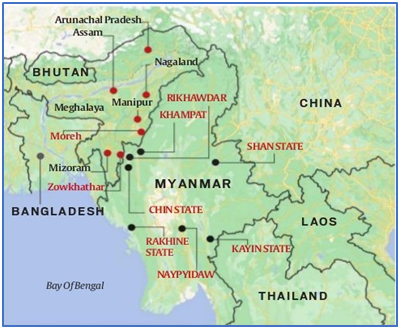New Flare-Up in Myanmar
18-11-2023
10:04 AM
1 min read

What’s in today’s article?
- Why in news?
- Background: ongoing fighting in the Rikhawdar area
- The current round of fighting
- How is the current situation different from the protests and fighting of the last two years?
- What does this situation mean for India?

Why in news?
- The Ministry of External Affairs has expressed deep concern over the ongoing fighting in the Rikhawdar area in Myanmar’s Chin State.
- The area is close to the border with India opposite Zowkhathar in Mizoram.
- This fighting has led to Myanmarese nationals crossing to the Indian side.
Background
- Myanmar has been in flames ever since the military seized power on February 1, 2021.
- On this day the new parliament elected after the November 2020 elections was to convene.
- Ethnic Armed Organisations (EAOs) have joined armed civilian groups called People’s Defence Forces (PDFs) to take on the military.
- These groups have allied with the country’s self-declared National Unity Government in exile.
- The resistance forces have captured two towns close to the India-Myanmar border after fierce fighting.
- The fall of the latter, Rikhawdar, has resulted in the influx of some 5,000 refugees into Mizoram.
The current round of fighting
- It began on October 27 with surprise attacks in Shan State in North Myanmar along the border with China, by the Three Brotherhood Alliance.
- The alliance is a front of three EAOs:
- the Myanmar National Democratic Alliance Army (MNDAA),
- the Ta’ang National Liberation Army, and
- the Arakan Army.
- The alliance is a front of three EAOs:
- The offensive was named Operation 1027, after the date on which it was launched.
- The resistance forces are reported to have overrun more than 100 military outposts in Shan State and seized control of crucial border towns and checkpoints.
- This includes Chinshwehaw, a critical point on the China-Myanmar border trade route, which is an important source of revenue for the junta.
- Fighting has also broken out elsewhere in the country, led by various local resistance forces.
How is the current situation different from the protests and fighting of the last two years?
- Fierce multi-pronged resistance
- Despite a brutal crackdown, including carrying out airstrikes on rebel gatherings, the junta has not succeeded in establishing control over large parts of the country.
- The ongoing multi-pronged offensive by the resistance forces is seen as the stiffest challenge to the junta since the coup more than two and a half years ago.
- Members of the Myanmar army and police are surrendering
- Among those who fled to Mizoram after Rikhawdar was captured by Chin fighters, were 73 members of the Myanmar army and police.
- Rebel groups have claimed that members of the junta forces have surrendered elsewhere, too.
- Coordination among the various rebel groups
- What distinguishes the current offensive is:
- the unprecedented level of coordination among the various rebel groups, and
- the inability of the military to mount an adequate response.
- What distinguishes the current offensive is:
- Support from China
- The resistance in Shan State appears to be receiving tacit support from China, Myanmar’s giant neighbour and biggest trade partner.
- China has been pressing the military government to crack down on the enclaves of scam centres on the Myanmar-China border, which have been targeting Chinese citizens.
- Country might be split into various parts
- If the government does not effectively manage the incidents happening in the border region.
What does this situation mean for India?
- Creating a balance
- India has so far walked a fine line between expressing concern at the interruption of democracy in Myanmar, and engaging with the junta to protect its vital interests.
- Immediate concern for India
- The influx of Myanmarese nationals in the border states of the Northeast.
- This too at a time when the situation in Manipur remains volatile.
- Capturing of two important towns by rebels
- The anti-junta forces have captured two important towns close to the only two border crossing points between Myanmar and India. These are:
- Rikhawdar, close to Zokhawthar in Mizoram, and
- Khampat in Sagaing region, around 60 km from Moreh in Manipur.
- The latter (Khampat in Sagaing region) is also part of the proposed India-Myanmar-Thailand trilateral highway project.
- The anti-junta forces have captured two important towns close to the only two border crossing points between Myanmar and India. These are:
Q1) What is Rikhawdar area?
Rikhawdar is a border town in the Falam District of Chin State, Myanmar. It's located opposite Zokhawthar in Mizoram, India. The town is also known as Rih.
Q2) What is India-Myanmar-Thailand trilateral highway project?
The 1,400-kilometer highway begins in Moreh in India's Manipur state, passes through Myanmar, and ends at Mae Sot in Thailand.
Source: The new flare-up in Myanmar | Indian Express


